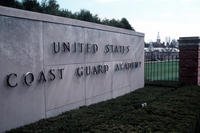A Marine Corps pilot was to blame for a coastal crash of an MV-22 Osprey off the northern coast of Okinawa, Japan, last December, the service announced Monday in a brief statement.
The crash, which was initially described by the service as a shallow-water landing until images emerged of the splintered and fragmented Osprey, resulted in a brief emergency grounding of all V-22s in the Pacific for safety checks.
The five Marines aboard the aircraft were injured in the crash, but all survived.
The grounding was lifted Dec. 19, six days after the Dec. 13 crash.
In an Okinawa press conference following the incident, III Marine Expeditionary Force commander Lt. Gen. Lawrence Nicholson said the Osprey was conducting aerial refueling operations over water when the rotor blades hit the refueling line.
"After the aircraft was unhooking, it was shaking violently," Nicholson said, according to remarks reported in a III MEF news release from the time. "The pilot made a decision to not fly over Okinawan homes and families. He made a conscious decision to try to reach Camp Schwab ... and land in the shallow water to protect his crew and the people of Okinawa."
Military.com has made multiple efforts to obtain the results of the command investigation into the crash, but the request has been denied as the investigation was ongoing.
In a February memo to Military.com in response to the first request, officials with 1st Marine Aircraft Wing said some information was not publicly releasable because it was covered by attorney-client privilege.
At the time, however, III MEF officials said no charges had been filed against any Marines involved in the crash.
In a III MEF release Monday, officials confirmed Nicholson's description of the event, saying the Osprey's right propeller made contact with another plane's refueling basket and hose during refueling operations roughly 30 kilometers, or about 19 miles, off the coast of Okinawa.
With a damaged propeller, the pilots decided not to fly over a populated area and made an "emergency controlled water landing, under powered flight," coming down about two miles southeast of Higashi.
The release does not specify what errors were made to cause the damage and subsequent crash.
"I want to again thank the Japan Coast Guard, Okinawan Police and the U.S. Air Force 33rd and 31st Rescue Squadrons for their support and assistance during this incident," Nicholson said in a statement.
"This was a regrettable incident but one that could have been much worse without the quick reaction of the crew and the support of our Okinawan and Air Force partners," he said. "We will continue safe flight operations of the MV-22 and all of our aircraft in support of our alliance with Japan."
-- Hope Hodge Seck can be reached at hope.seck@military.com. Follow her on Twitter @HopeSeck.































